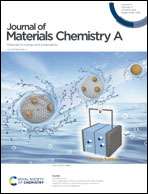Polyaddition enabled functional polymer/inorganic hybrid electrolytes for lithium metal batteries†
Abstract
The exploration for solid electrolytes to replace conventional organic liquid electrolytes paves the way for producing next generation lithium secondary batteries. Herein, a new class of polymer/inorganic hybrid electrolytes (HEs) were prepared through polyaddition reactions and these electrolytes effectively integrated polyether, ionic liquids (ILs), silsesquioxane cages, and supramolecular interactable units. Besides their excellent thermal stability (up to 275 °C) and low glass transition temperature (−45.5 °C), they were able to self-heal their incision quickly (within 100 min) at ambient temperature. They also exhibited high ionic conductivity (0.34 × 10−4 S cm−1 at 25 °C) among plasticizer-free solid polymer-based electrolytes and their ion transport properties could be conveniently tuned by adjusting the composition. Meanwhile, they revealed excellent long-term (>800 h) electrochemical compatibilities with lithium electrodes in galvanostatic cycling tests. The coin cell lithium solid batteries assembled with this class of HEs showed good performance. This work provides a novel hybrid electrolyte system towards the development of smart solid electrolytes for next generation lithium batteries.

- This article is part of the themed collection: Journal of Materials Chemistry A HOT Papers


 Please wait while we load your content...
Please wait while we load your content...